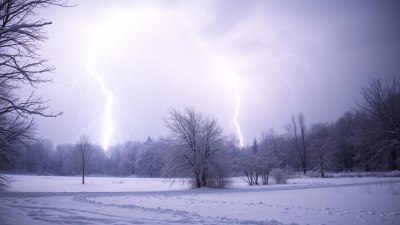Why Do Weather Apps Say ‘Feels Like’ - Isn’t That Just the Temperature
Ever wondered why the “feels like” temperature is different from the actual temperature? Here’s what it really means - and why it matters.

You check your weather app, and it says it’s 50°F, but it “feels like” 42°F. Wait—how can it feel colder than it actually is? Isn’t temperature just temperature? Not exactly. The “feels like” temperature takes into account more than just the thermometer reading. It calculates how weather conditions like wind, humidity, and sun exposure affect how hot or cold it feels on your skin. Here’s how it works—and why it’s more accurate than you think.
1. Wind Chill: Why Cold Feels Colder
When it’s cold and windy, the “feels like” temperature drops because of wind chill. Wind removes the thin layer of warm air surrounding your body, making you feel colder than the actual air temperature. The stronger the wind, the more heat you lose, which is why 30°F with a strong wind can feel like 20°F or even lower. This is especially dangerous because wind chill increases the risk of frostbite and hypothermia.
2. Humidity: Why Hot Feels Hotter
In the summer, humidity makes the air feel hotter than the actual temperature because it affects how your body cools itself. Normally, you sweat and it evaporates, cooling you down. But in high humidity, the air is already full of moisture, slowing down the evaporation process. This causes your body to overheat and feel much warmer than the temperature on the thermometer. This is known as the heat index.
3. Direct Sunlight: The Secret Heat Booster
Ever notice how it feels way hotter in direct sunlight? That’s because the sun’s radiation heats your skin and clothing directly, making you feel warmer than the shade temperature. Weather apps don’t always account for this, but the “feels like” temperature sometimes includes solar radiation when it’s significant. This is why 75°F can feel like 85°F on a sunny day with no breeze.
4. Ground Temperature: Closer to the Source
Air temperature is measured about six feet above the ground, but the ground itself can be much hotter or colder. Asphalt and sand, for example, can heat up rapidly under direct sunlight, radiating extra heat and making you feel hotter. On cold days, snow or ice can reflect cold temperatures back at you, making you feel colder than the air temperature.
5. Clothing and Activity Level: Personal Factors Matter
While the “feels like” temperature is standardized, how it feels to you personally also depends on your clothing and activity level. If you’re dressed lightly or not moving much, you’ll feel colder. If you’re layered up or active, you’ll feel warmer. This is why the “feels like” temperature is an estimate, not an absolute.
6. Why It Matters: Safety and Comfort
The “feels like” temperature isn’t just for curiosity—it’s crucial for staying safe and comfortable. Knowing the wind chill can help you dress warmly enough to avoid frostbite. Understanding the heat index can help you avoid heat exhaustion or heat stroke. By factoring in wind, humidity, and sunlight, the “feels like” temperature gives a more accurate picture of weather risks.
7. How It’s Calculated
The “feels like” temperature is calculated using complex formulas that consider:
- Wind chill: Combines wind speed and air temperature.
- Heat index: Combines temperature and humidity levels.
- Solar radiation: In some models, sunlight exposure is factored in.
These calculations are based on how the human body gains or loses heat in different weather conditions, making them more reliable than just the thermometer reading.
The Verdict: It’s More Than Just a Number
The “feels like” temperature isn’t just an opinion—it’s a scientific calculation of how weather conditions affect your body. By taking into account wind chill, humidity, sunlight, and more, it gives a more accurate representation of how the weather actually feels. So next time you check your weather app, pay attention to the “feels like” temperature. It’s not just a number—it’s how you’ll actually feel when you step outside.











